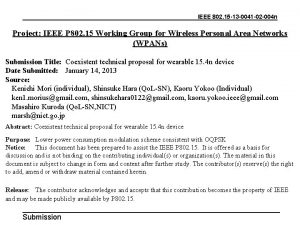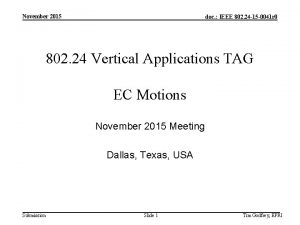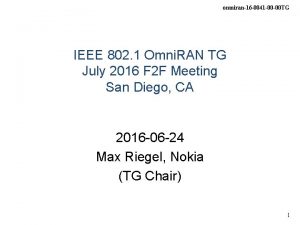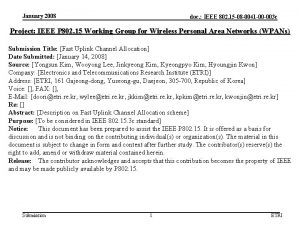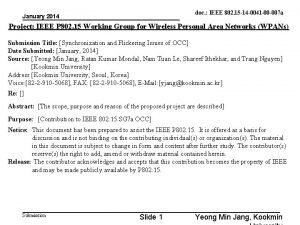IEEE 802 15 13 0041 01 004 n







- Slides: 7

IEEE 802. 15 -13 -0041 -01 -004 n Project: IEEE P 802. 15 Working Group for Wireless Personal Area Networks (WPANs) Submission Title: Coexistent technical proposal for wearable 15. 4 n device Date Submitted: January 14, 2013 Source: Kenichi Mori (individual), Shinsuke Hara (Qo. L-SN), Kaoru Yokoo (Individual) ken 1. morius@gmail. com, shinsukehara 0122@gmail. com, kaoru. yokoo. ieee@gmail. com Masahiro Kuroda (Qo. L-SN, NICT) marsh@nict. go. jp Abstract: Coexistent technical proposal for wearable 15. 4 n device Purpose: Lower power consumption modulation scheme consistent with OQPSK Notice: This document has been prepared to assist the IEEE P 802. 15. It is offered as a basis for discussion and is not binding on the contributing individual(s) or organization(s). The material in this document is subject to change in form and content after further study. The contributor(s) reserve(s) the right to add, amend or withdraw material contained herein. Release: The contributor acknowledges and accepts that this contribution becomes the property of IEEE and may be made publicly available by P 802. 15. Submission

IEEE 802. 15 -13 -0041 -01 -004 n Our proposal In addition to “ 15 -12 -0588 -02 -004 n-technical-proposal-forwearable-15 -4 n-device” we discussed at the last meeting, we propose a harmonization in modulation schemes with OQPSK. Submission

IEEE 802. 15 -13 -0041 -01 -004 n GFSK coexistence with OQPSK • GFSK is common in IEEE 802. 15. 6 and 15. 4 g • GFSK is very power-efficient, because it has a constant envelop nature • Transmission power limit of 10 m. W should be applied to not only DSSS OQPSK PHY but also GFSK PHY, which allows to support on-body/off-body wireless communications (bedside monitoring) as well as on-body/on-body and on-body/inbody wireless communications • Parameterize the use of BT, such as BT=0. 3 or =0. 5 Submission

IEEE 802. 15 -13 -0041 -01 -004 n Our GFSK proposal • Our GFSK supports 200 kbps-data transmission rate per 500 k. Hz channel spacing • 200 kbps is affordable for medical devices to retrieve data from human body including high-demanding 12 -lead ECG (16 bits, 1 ms) Ideal PSD of GFSK Simulation condition Same modulation scheme as IEEE 802. 15. 4 g Modulation index = 0. 5 BT of Gaussian filter = 0. 5 -46 d. Br 500 k. Hz Submission Note: An example of BT=0. 5 in the Gaussian low pass filter.

IEEE 802. 15 -13 -0041 -01 -004 n Our GFSK proposal (cont. ) • Our band plan is shown as below a) Good coexistence with OQPSK b) Large number of channels (see annex) c) Channel overlapping by 0. 5 channel bandwidth if needed - relax ACLR spec that gives impact to an out-band system - easy to find unoccupied frequency band d) Support up to 400 kbps by 2 channels aggregation a, b OQPSK 2 MHz mode d OQPSK 2 MHz mode 500 k. Hz OFDM (DTV) freq. c frequency boundary between 4 n and another system Half shift can relax leakage power spec to an out-band systems c Submission freq.

IEEE 802. 15 -13 -0041 -01 -004 n Band Plan In a case without considering channel overlapping Frequency Band [MHz] (BW) Modulation Bit Rate [kb/s] Channel Spacing [k. Hz] Number of Channels 174 – 216 (42 MHz) Filtered FSK 200 400 105 407 -425 (18 MHz) Filtered FSK 200 45 608 -630 (22 MHz) Filtered FSK 200 400 55 Submission

IEEE 802. 15 -13 -0041 -01 -004 n Summary • Filtered FSK and/or O-QPSK are preferable for wearable devices used for healthcare applications in hospitals and clinics and filter type is proposed • Band plan is proposed Submission








